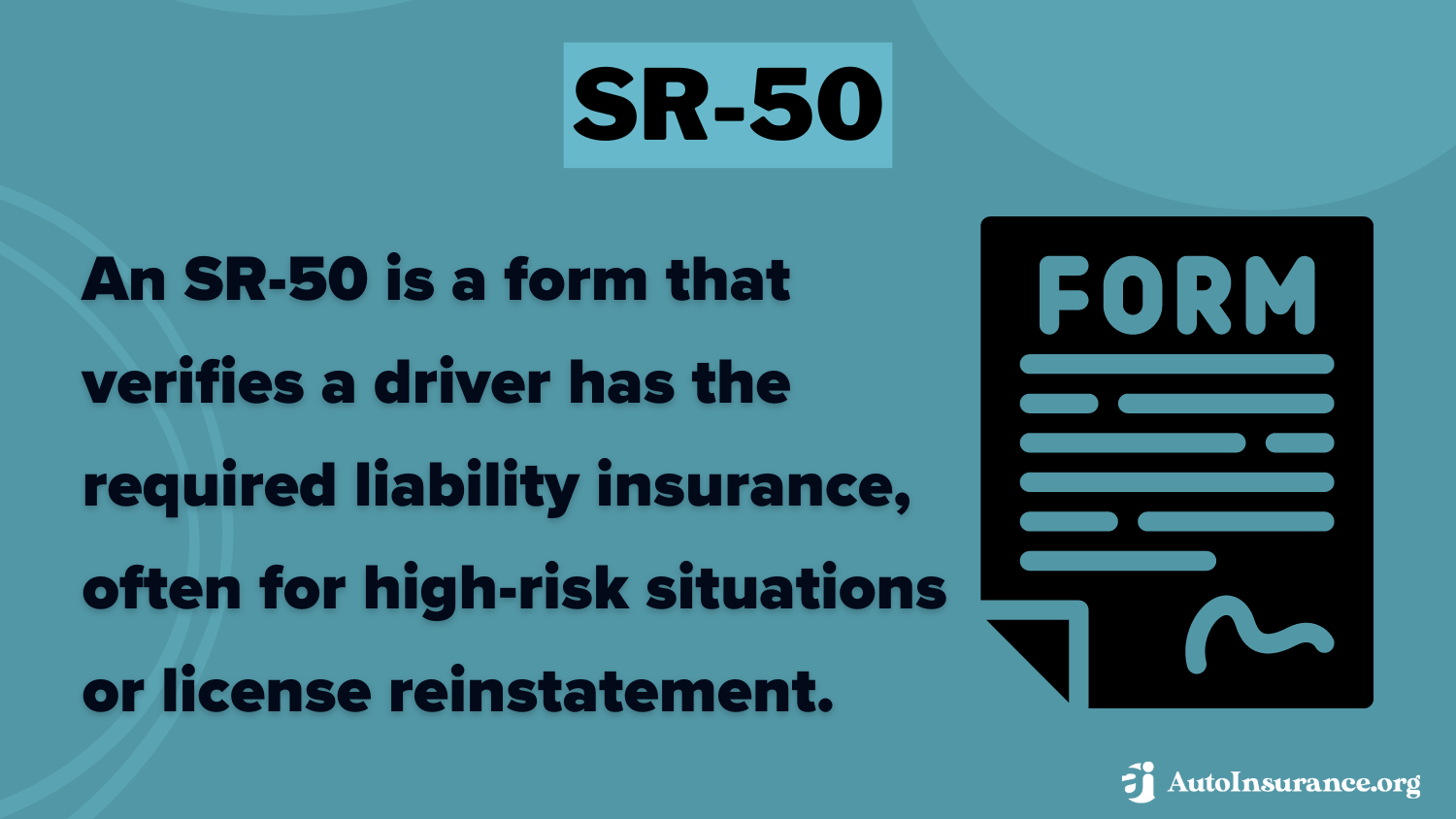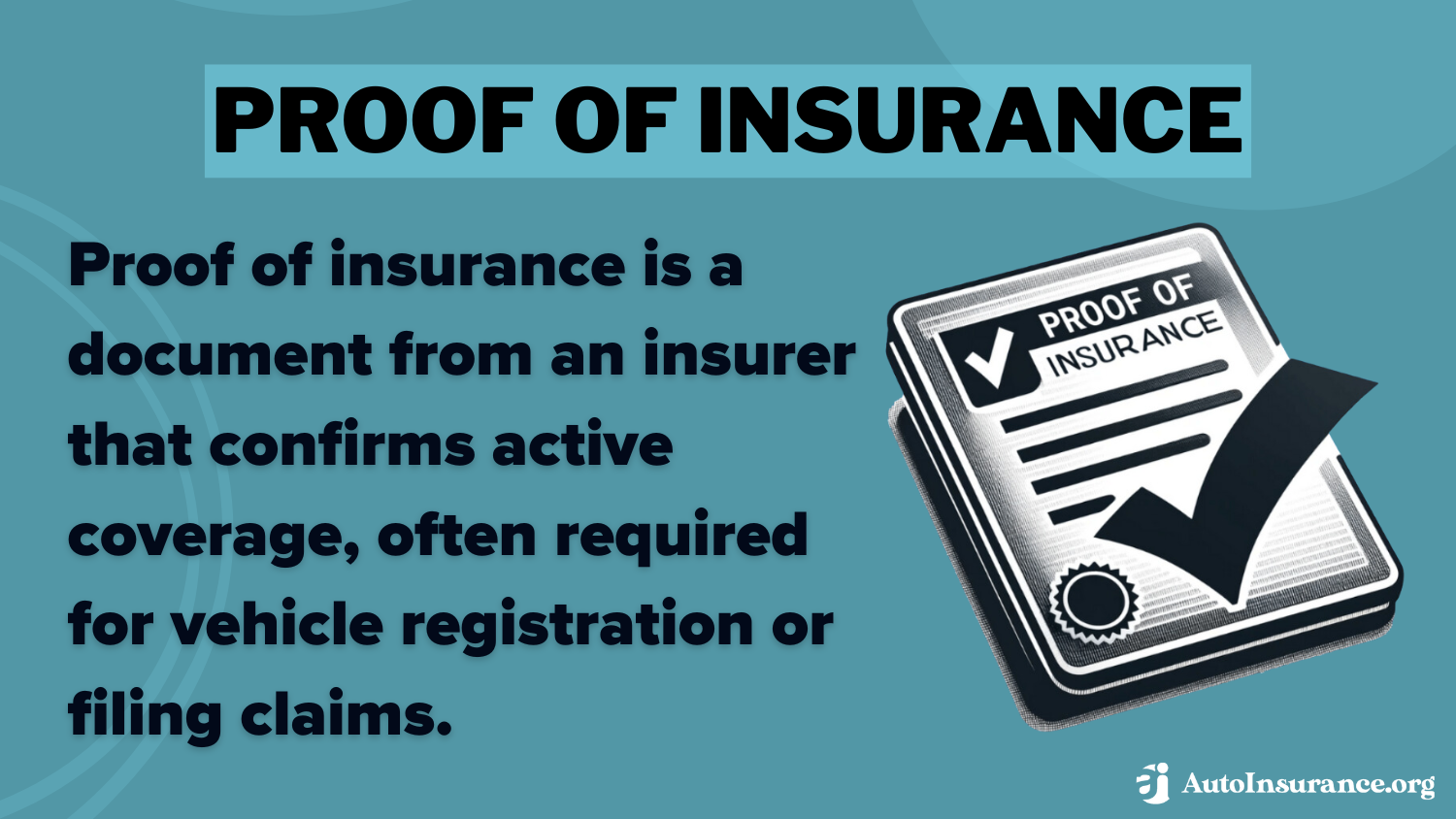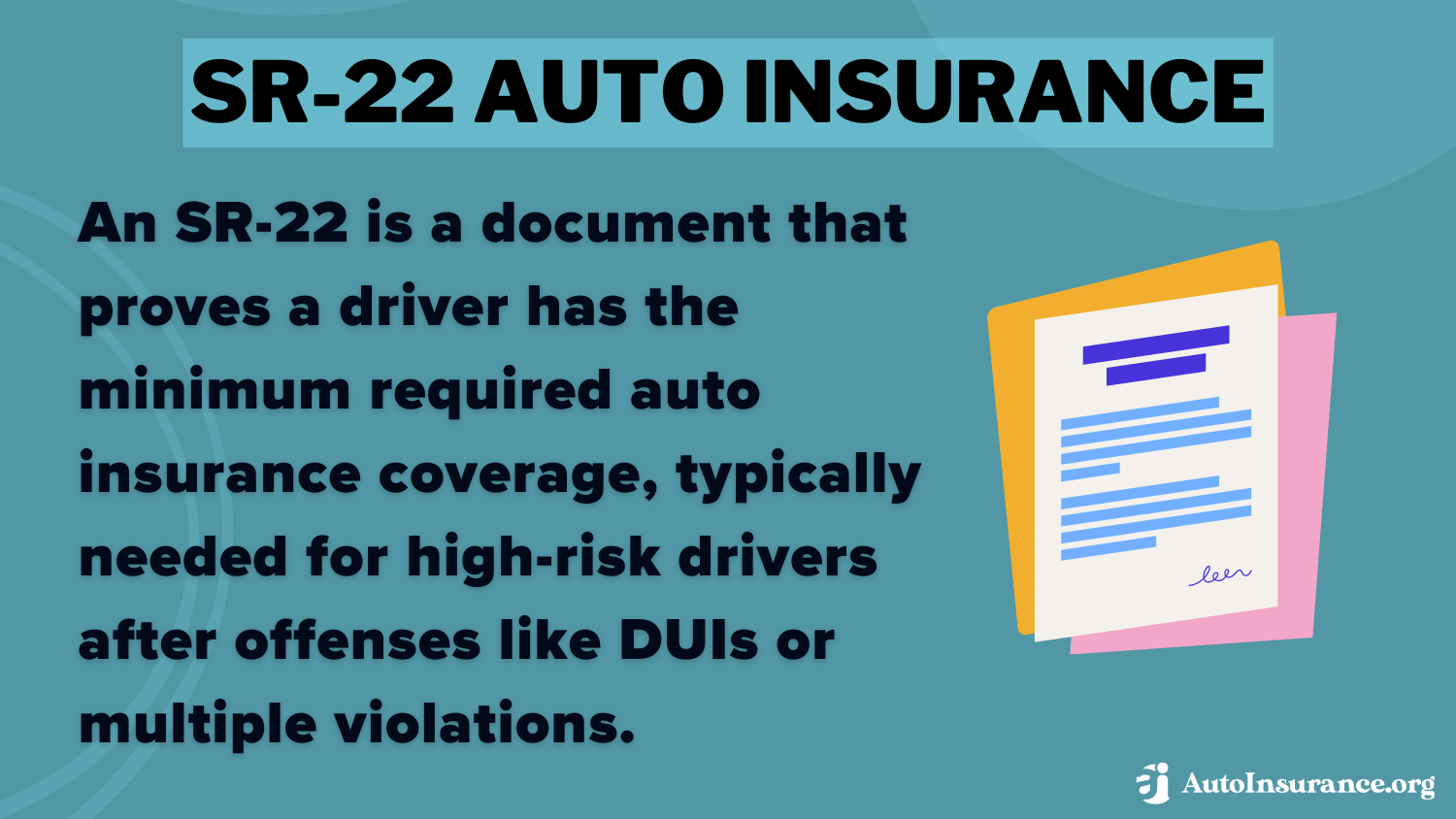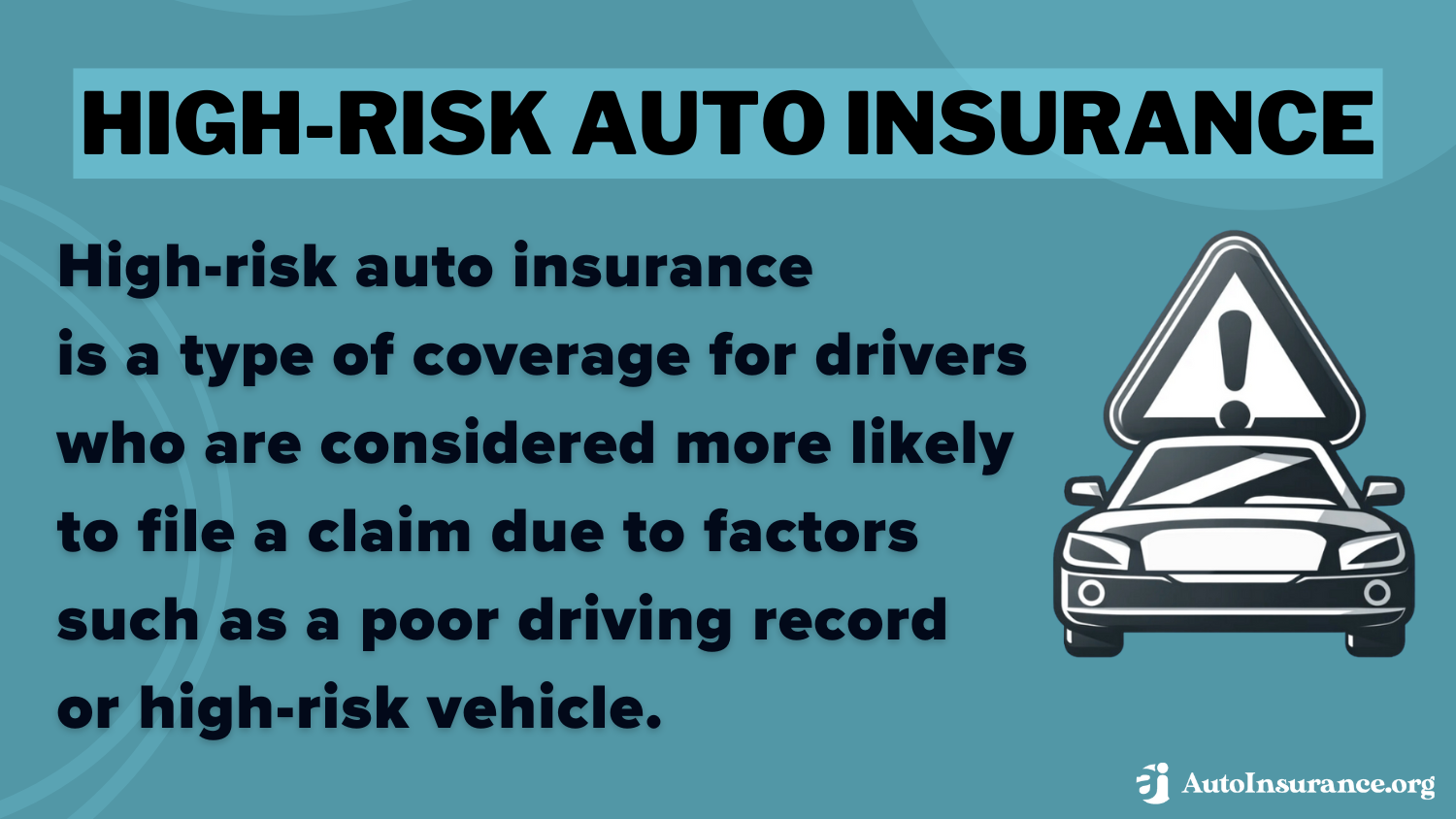SR-50 Auto Insurance in 2025 (Coverage Explained)
SR-50 auto insurance is required for high-risk drivers in Indiana, ensuring you have the coverage needed to get your license back. Starting at just $50 a month, SR-50 coverage keeps you in line with state rules and helps you dodge fines of up to $300. Here’s how SR-50 insurance keeps you covered on the road.

Free Car Insurance Comparison
Compare Quotes From Top Companies and Save
Secured with SHA-256 Encryption
Tim Bain
Licensed Insurance Agent
Tim Bain is a licensed insurance agent with 23 years of experience helping people protect their families and businesses with the best insurance coverage to meet their needs. His insurance expertise has been featured in several publications, including Investopedia and eFinancial. He also does digital marking and analysis for KPS/3, a communications and marking firm located in Nevada.
Licensed Insurance Agent
UPDATED: Nov 6, 2024
It’s all about you. We want to help you make the right coverage choices.
Advertiser Disclosure: We strive to help you make confident auto insurance decisions. Comparison shopping should be easy. We are not affiliated with any one auto insurance provider and cannot guarantee quotes from any single provider. Our partnerships don’t influence our content. Our opinions are our own. To compare quotes from many different companies please enter your ZIP code on this page to use the free quote tool. The more quotes you compare, the more chances to save.
Editorial Guidelines: We are a free online resource for anyone interested in learning more about auto insurance. Our goal is to be an objective, third-party resource for everything auto insurance related. We update our site regularly, and all content is reviewed by auto insurance experts.
UPDATED: Nov 6, 2024
It’s all about you. We want to help you make the right coverage choices.
Advertiser Disclosure: We strive to help you make confident auto insurance decisions. Comparison shopping should be easy. We are not affiliated with any one auto insurance provider and cannot guarantee quotes from any single provider. Our partnerships don’t influence our content. Our opinions are our own. To compare quotes from many different companies please enter your ZIP code on this page to use the free quote tool. The more quotes you compare, the more chances to save.
On This Page
SR-50 auto insurance is a must-have for high-risk auto insurance drivers in Indiana, helping you prove you’ve got the coverage needed to get your license back or avoid fines up to $300.

This insurance helps keep you driving legally, whether your license is suspended or if you need non-owner coverage. Starting from only $50 monthly, it assists you in keeping up with state rules. Drivers who fail to provide an SR-50 form can face penalties, including license suspension and reinstatement fees.
This guide breaks down everything you need to know about SR-50, why it’s important, and how it works to keep you covered. Explore your auto insurance options by entering your ZIP code into our free comparison tool below today.
- The SR-50, unique to Indiana, is an affidavit of current insurance
- Filing the SR-50 may be needed to restore driving privileges
- Suspended licenses make insurance harder to get for high-risk drivers
Understanding SR-50 Auto Insurance
When you purchase an insurance policy, that automatically comes with proof of coverage, so why do you need proof of SR-50 coverage? Wouldn’t simply printing out a copy of your policy as proof of insurance and mailing it to the state be sufficient?
No. When high-risk drivers are required to provide proof of SR-50 insurance, the state wants official paperwork from the SR-50 auto insurance company, rather than relying on the driver to provide it.
Additionally, certain forms are designed to reflect specific circumstances related to the driver’s history. A standard proof of insurance card would not be sufficient for these drivers. Learning how to manage your auto insurance policy effectively can help you understand when special documents like the SR-50 are required.
Again, an SR-50 comes into play for high-risk drivers, including those whose driving privileges have been suspended due to recklessness behind the wheel. The state won’t reinstate a driver’s license unless the SR-50 document is filed with the Indiana BMV to get a suspended license reinstated.
Furthermore, SR-50 auto insurance in Indiana is essential for drivers who need to prove they have insurance, especially when required by the state after specific incidents. For those who do not own a vehicle but still need to drive, SR-50 insurance for non-owners offers necessary coverage.
This type of insurance is crucial for complying with legal requirements and ensuring you are protected while driving someone else’s car. In Indiana, a non-pointable violation in Indiana refers to traffic infractions that do not add points to your driving record, which can be relevant when managing your insurance status and claims.
Additionally, understanding the law of collision is important, as it dictates how insurance claims are processed following accidents, emphasizing the importance of having the right type of insurance coverage like SR-50.
Free Auto Insurance Comparison
Enter your ZIP code below to view companies that have cheap auto insurance rates.
Secured with SHA-256 Encryption
Indiana SR-50 and Auto Insurance Coverage
As we noted previously, SR-50 form requirements are unique to Indiana auto insurance. So what does this mean for you? Do you need SR-50 insurance in Indianapolis? What about non-owner SR-50 insurance? Just what is SR-50 insurance? Keep reading to find out the answers to these and other questions.
Additionally, the main function of insurance is to offer financial protection against unexpected events, ensuring that individuals are shielded from significant financial losses. In the context of Indiana SR-50 and Auto Insurance Coverage, this protection becomes crucial.
Failing to file an SR-50 can lead to fines of up to $300 and potential license suspension.Daniel Walker Licensed Auto Insurance Agent
Insurance helps cover the costs associated with damages and injuries resulting from auto accidents, reducing the financial burden on the insured. By providing this coverage, insurance enables drivers to manage potential risks and comply with legal requirements, such as those outlined in SR-50.
Furthermore, insurance protection is essential for safeguarding individuals from the financial impact of accidents. Knowing the definition of an auto accident—which includes any incident involving vehicles that leads to damage or injury—helps in understanding the type of coverage required.
The most common type of car accident often involves collisions like rear-end crashes, emphasizing the need for comprehensive insurance. Additionally, the life benefit in insurance supports beneficiaries financially if the policyholder passes away, highlighting the broad range of protection insurance provides against various risks.
Comparing SR-50 Insurance Rates by Provider
SR-50 Auto Insurance Cost by Provider
| Insurance Company | Monthly Rate |
|---|---|
| $65 | |
| $80 | |
| $75 | |
| $60 | |
 | $85 |
 | $70 |
| $55 | |
 | $95 |
| $50 | |
| $90 |
State Farm offers the lowest rate, $50 a month, a great pick for budget-conscious drivers. Progressive isn’t far behind at $55, and Geico offers a solid deal at $60. On the pricier side, Safe Auto charges $95. By checking out these rates, drivers can find the best fit for their budget and coverage needs.
SR-50 Auto Insurance in Indiana
The “SR” meaning is “Safety Responsibility.” The full title of an SR-50 document is an “Affidavit of Current Insurance.” As the name suggests, the form contains proof that a driver currently carries car insurance.
Specifically, under Indiana state auto insurance laws, the driver must carry the minimum amount of insurance required in Indiana, which is summarized in this table.
Indiana Minimum Liability Coverage Requirements
| Liability Coverage Types | Minimum Amount of Coverage Required |
|---|---|
| Bodily Injury | $25,000 per person $50,000 per accident |
| Property Damage | $10,000 |
At the state level, no requirement exists to purchase more than the minimum coverage amount.
However, newly written auto policies must include coverage for bodily injury and property damage caused by uninsured/underinsured motorists. Policyholders have the option to reject this coverage in writing.
In most cases, an SR-50 form is only necessary if you receive a notification from the state informing you of the requirement. This is usually the result of an incident in which you were found to be driving without insurance.
You may also be required to obtain an SR-50 form if your license was suspended. In this case, the requirement is part of the process for getting your license reinstated.
If required by the state, your insurance company will issue the SR-50 form, which will then be sent to the Indiana Bureau of Motor Vehicles as proof of financial responsibility.
Also, in Indiana, SR-50 auto insurance plays a critical role for drivers who need to meet state requirements, especially after an accident. If a driver experiences failure to provide proof of insurance in Indiana, they must correct this by providing appropriate documentation.
In such situations, the Indiana BMV proof of insurance after an accident is essential to confirm that the driver has valid coverage. Additionally, the Indiana BMV certificate of compliance is needed to show that the driver is adhering to state insurance laws.
The SR-50 form is specifically used to provide this proof of insurance and is crucial for ensuring that drivers meet legal requirements and maintain proper coverage.
Free Auto Insurance Comparison
Enter your ZIP code below to view companies that have cheap auto insurance rates.
Secured with SHA-256 Encryption
Requirements for SR-50 Auto Insurance in Indiana
The SR-50 form is generally required by the state when you’re considered a particularly high-risk driver (specifically when you’ve been caught driving without insurance). In addition, high-risk drivers whose licenses have been suspended will be required to produce an SR-50 form as a part of the process of license reinstatement.
Drivers struggling with previous moving violations and license suspensions may feel overwhelmed when it comes to purchasing auto insurance. But this process doesn’t have to be difficult or overly time-consuming. You can quickly and easily get quotes from multiple companies that offer high-risk insurance coverage by comparison shopping.
Also, for Indiana drivers, understanding the purpose of SR-50 auto insurance is essential for complying with state requirements. This form of insurance ensures drivers provide adequate proof of coverage. Drivers may also need to be familiar with the SR-16 form, which is used for different insurance purposes in various states.
Similarly, SR-22 insurance in Oregon serves a comparable function, proving financial responsibility, though specific to that state. Understanding the best Oregon auto insurance options can help drivers make informed choices. All these requirements are based on the Seven principles of insurance, which include risk management and financial security.
To comprehend the value of these documents and policies, knowing the simplest definition of insurance—a tool for protecting against financial loss—is helpful. Ultimately, understanding insurance benefits can guide Indiana drivers in meeting their insurance obligations and ensuring proper coverage.
Understanding Non-Pointable Violations in Indiana
A non-pointable traffic violation is typically one that is classified as a non-moving violation, while moving violations are usually considered pointable.
What is the difference between a moving violation and a non-moving violation? A moving violation is one that typically occurs while you’re behind the wheel and the vehicle is in motion. These can include speeding, running a red light, not using your turn signal, etc.
By contrast, non-moving violations typically include citations for improper parking, inability to prove adequate insurance coverage, etc. Also, in Indiana, a non-pointable violation refers to specific traffic infractions that do not add points to a driver’s record. These violations are considered less severe and do not affect a driver’s insurance rates or driving record as other violations might.
When your budget 🔢is stretched to the max, you need to find a balance⚖️ between car insurance coverage and premiums. We have tips to help you find what you need as well as our top 10 list picks👉: https://t.co/3H5IJVVPnP pic.twitter.com/l79FE6Pyaa
— AutoInsurance.org (@AutoInsurance) October 21, 2024
Understanding non-pointable violation is crucial for managing your Indiana state auto insurance, as insurance companies in Indiana often base rates on the driver’s point record. By being aware of which violations are non-pointable, drivers can better navigate their insurance policies and potentially avoid higher premiums.
For individuals who do not own a vehicle but still need to drive, cheap non-owner auto insurance is a valuable option. This type of insurance provides coverage for drivers who operate vehicles that are not their own. Additionally, knowing the three types of collisions—rear-end, side-impact, and head-on—can help drivers understand the types of accidents that may impact their insurance claims.
By comprehending the implications of non-pointable violations and choosing the right coverage through insurance companies in Indiana, drivers can effectively manage their insurance needs and ensure they have appropriate protection.
Navigating the SR-50 Auto Insurance Process
In addition to the SR-50, drivers may also be required to work with their insurers to present a Certificate of Compliance, which is a stricter insurance requirement than in many other states. The Indiana BMV COC form must be filed if any of these four conditions are met:
- An auto accident occurs and an accident report is submitted to the BMV.
- The driver receives a “pointable” moving violation within one year of committing two other pointable violations.
- The driver’s traffic violation is considered either a misdemeanor or a felony.
- A driver, after a prior suspension for failing to show proof of coverage, receives a pointable violation.
In addition to these four conditions, the COC may be required under other circumstances if the state deems it necessary. Per the law, Indiana may request proof of auto insurance at will and under any circumstances.
Ultimately, the state wants to be absolutely sure a high-risk driver carries insurance. Subsequently, when obtaining SR-50 auto insurance, it’s important to understand the different aspects of collision coverage and how they relate to your policy. For instance, an example of a collision could be a rear-end crash, where one vehicle hits another from behind.
With SR-50, high-risk drivers can meet state requirements and regain their driving privileges.Michelle Robbins Licensed Insurance Agent
This type of incident is classified under collision in a car, which involves any direct impact between vehicles. The definition of collision auto insurance is coverage that helps pay for damages to your vehicle resulting from these types of accidents, whether they are head-on collisions or side impacts.
Additionally, grasping the meaning of a vehicle collision is crucial for understanding what your SR-50 auto insurance will cover. In some scenarios, you might encounter terms like 50/50 in a car accident, which means that liability for the accident is equally shared between the involved parties.
Knowing these details helps you better navigate your insurance needs and ensures that you have the right coverage in place for various types of collisions.
Free Auto Insurance Comparison
Enter your ZIP code below to view companies that have cheap auto insurance rates.
Secured with SHA-256 Encryption
Importance of Meeting SR-50 Auto Insurance Requirements
If your driver’s license was suspended, the state of Indiana will require that a basic auto insurance policy is in place before restoring lost driving privileges, as a method of managing risk both for you and others on the road.
Why? Because someone whose driving habits resulted in accruing enough points to suspend their license is extremely high risk and is more likely to be an accident risk than the average driver.
Clearly, someone who chooses not to carry insurance, in violation of the state’s rules, reflects a risk. So providing the BMV with an SR-50 a proof of insurance is necessary before the state will to reissue a license.
For high-risk drivers, one major concern is how to purchase affordable SR-50 auto insurance after a suspension and poor driving history. Seeking policies from the best auto insurance companies for high-risk drivers can make this process easier.
While finding high-risk auto insurance coverage can be difficult, it is possible. Comparison shopping for quality car insurance can help you find better rates.
Understanding High-Risk Drivers
High-risk drivers are typically those with numerous moving violations on their record.
As you might expect, drivers with multiple points on their record, those who have been convicted of DUI, or have had their license suspended are considered high-risk. However, a policyholder whose insurance history shows numerous claims may also be considered high-risk.
As we noted earlier, finding insurance as a high-risk driver can be difficult (not every insurance company wants to take on the extra cost associated with insuring high-risk drivers).
As a result, it pays to be strategic about shopping for insurance. For example, if you only speak to one or two auto insurance companies, you might find yourself unable to find a policy.
However, instead of reaching out to individual insurance companies, one recommended option is to online comparison shop. This way, you can get multiple SR-50 auto insurance quotes from different car insurance companies so you can see who offers the best coverage at the most affordable price.
High-risk insurance costs more, but comparison shopping can help find competitive SR-50 rates. Choosing the right coverage is crucial to manage risks and ensure broad protection.
This is similar to a comprehensive protection plan, which includes coverage for damages that are not related to collisions, such as theft or natural disasters. High-risk drivers often benefit from such comprehensive auto insurance coverage due to their higher likelihood of filing claims.
In addition to these plans, understanding the meaning of guaranty insurance is important, as it ensures that claims will be paid even if the insurance company fails. For those in Indiana, Indiana high-risk auto insurance specifically caters to drivers with a history of violations or accidents, offering coverage that might be more challenging to obtain elsewhere.
Although HO6 insurance is generally used for condo owners and does not directly apply to auto insurance, it illustrates the broader spectrum of insurance options available to address various risks and needs. By exploring these insurance solutions, high-risk drivers can ensure they have adequate protection and manage their insurance needs effectively.
The Importance of Extra Coverage for High-Risk Drivers
The cost of acquiring mandatory minimum coverage may be higher for a previously suspended driver than for someone with no infractions, so finding cheap SR-50 insurance in Indiana may be difficult.
We don’t currently have rates for high-risk drivers in Indiana, but in this table, we’ve summarized the average rates for core coverage options for all drivers in the state as a baseline.
Indiana Average Annual and Monthly Auto Insurance Rates by Coverage Type
| Auto Insurance Coverage Types | Average Annual Rates | Average Monthly Rates |
|---|---|---|
| Comprehensive Coverage | $115.02 | $9.59 |
| Collision Coverage | $237.19 | $19.77 |
| Liability Coverage | $372.44 | $31.04 |
| Full Coverage | $724.65 | $60.39 |
Expect to pay more than the rates in this table if you’re a high-risk driver. But also know that no matter what type of driver you are, it’s good to understand the basics of auto insurance.
While higher rates may mean drivers consider sticking to the minimum coverage requirement only, this is not necessarily recommended. In general, drivers should be more concerned about civil judgments than higher rates.
Paying for additional liability coverage as well as add-on coverage such as collision or comprehensive would probably be a good move.
High-risk drivers should consider purchasing enough coverage to protect themselves financially in the event of another incident.
The protections afforded by insurance should never be overlooked or taken for granted. Purchasing a reliable amount of coverage is in the best interest of all drivers—high-risk included.
Free Auto Insurance Comparison
Enter your ZIP code below to view companies that have cheap auto insurance rates.
Secured with SHA-256 Encryption
Key Distinctions Between SR-22 and SR-50 Coverage
Both SR-50 and SR-22 forms provide proof of insurance. However, there are a couple of differences. What is SR-22 insurance?
Let’s take a look at SR-50 vs. SR-22 auto insurance.
- The Sr-50 Is Proof of Active Insurance: The form certifies that you currently carry the legally required minimum level of car insurance in Indiana.
- The Sr-22 Is Proof of Future Insurance: The form certifies that you will carry the legal minimum amount of car insurance for a specific period into the future (usually 3 years).
Regardless of which form you’re required to have, your insurance company will electronically file it with the Indiana BMV.
If you are ready to buy SR-50 car insurance, use your ZIP code in our free quote tool below, Once you have the necessary coverage, you can work with the company to buy SR-50 auto insurance and fill out and submit your SR-50 form.
Frequently Asked Questions
What is SR-50 insurance?
SR-50 insurance is a form of proof required in Indiana for high-risk drivers to confirm they carry the state’s minimum auto insurance coverage, often after a suspension or traffic violation.
Which states require SR-50 auto insurance?
Currently, the SR-50 requirement is specific to Indiana. If you have committed certain offenses, such as being involved in an accident while uninsured, driving with a suspended license, or receiving a DUI conviction, the state may require you to file an SR-50 form.
What does an SR-50 form entail?
An SR-50 form is a document that verifies your auto insurance coverage and is filed with the state’s Department of Motor Vehicles (DMV) or the relevant authority. It provides proof that you meet the minimum auto insurance requirements by state to ensure compliance with local laws.
What are the pros of SR-50 auto insurance?
Are there any cons associated with SR-50 auto insurance?
SR-50 insurance comes with a few potential drawbacks. One of the main issues is higher premiums, as SR-50 coverage tends to be more expensive than standard auto insurance due to the increased risk associated with high-risk drivers. Additionally, your options may be limited when choosing an insurance provider, as not all companies offer this specialized coverage.
What is a non-pointable violation?
A non-pointable violation is a traffic infraction that does not add points to a driver’s record, such as parking violations or failure to provide proof of insurance. Understanding how auto insurance companies check driving records is crucial, as these companies often review your history to assess risk and determine your premiums, even for non-pointable violations.
What is cheap SR-50 insurance in Indiana?
Cheap SR-50 insurance in Indiana refers to affordable coverage options for high-risk drivers, with rates starting as low as $50 per month.
What is SR?
SR stands for “Safety Responsibility,” used in forms like SR-50 and SR-22 to certify a driver’s financial responsibility for maintaining auto insurance.
What is a non-pointable violation in Indiana?
In Indiana, a non-pointable violation is a traffic offense that doesn’t affect your driving record or insurance rates, such as certain non-moving violations. However, it’s still important to compare auto insurance rates regularly to ensure you’re getting the best deal, as other factors can still impact your premiums.
How much is SR-50 insurance?
SR-50 insurance typically starts at $50 per month, depending on the driver’s risk level and the insurance provider.
What is the Indiana BMV certificate of compliance?
The Indiana BMV certificate of compliance is a document proving a driver has valid auto insurance coverage, required after specific traffic violations or accidents.
Start saving on your auto insurance by entering your ZIP code below and comparing quotes.
What is Indiana BMV proof of insurance after an accident?
The Indiana BMV requires proof of insurance after an accident to confirm the driver had the necessary coverage at the time of the incident. You can get instant proof of your auto insurance policy online, making it easier to provide the required documentation promptly.
What does SR mean on a car?
SR on a car indicates “Safety Responsibility,” linked to forms like SR-22 or SR-50, which prove a driver’s financial responsibility for insurance.
What does SR-16 sent to BMV mean?
An SR-16 sent to the BMV indicates a report of a traffic violation, often involving the requirement to show proof of insurance or financial responsibility.
What is Indiana high-risk auto insurance?
Indiana high-risk auto insurance provides coverage for drivers with a history of violations or accidents, often at higher rates due to their increased risk. However, drivers can still find cheap auto insurance after an accident by shopping around and comparing rates from multiple providers.
What is non-owner SR-50 insurance?
Non-owner SR-50 insurance provides liability coverage for drivers who don’t own a vehicle but need to prove insurance to meet SR-50 requirements.
What does SR-16 mean?
SR-16 is a form used to notify the BMV of traffic violations and may require drivers to provide proof of insurance or compliance with financial responsibility laws.
What is an SR-16 Indiana?
In Indiana, an SR-16 is a document submitted to the BMV to report traffic offenses and ensure the driver complies with insurance requirements. It is one of the documents you need to get auto insurance after certain violations.
What is the SR-22 definition?
SR-22 is a certificate of financial responsibility required for high-risk drivers to prove they have the minimum required auto insurance coverage.
Who typically has the cheapest car insurance?
Drivers with clean records and good credit usually get the cheapest car insurance, often with rates starting around $50 per month.
What is the state minimum car insurance in Indiana?
How do I get rid of an SR-22 in Indiana?
To remove an SR-22 in Indiana, maintain continuous insurance coverage for the required period, usually three years, and then request removal from your insurance provider.
How long does an SR-22 last in Indiana?
In Indiana, an SR-22 is generally required for three years, but the duration may vary based on the specific violation.
How much is SR-22 insurance in Indiana?
SR-22 insurance in Indiana typically costs $70 to $100 per month, depending on the driver’s history and coverage needs. To ensure adequate protection, it’s important to consider recommended auto insurance coverage levels beyond the state minimums.
What is the average cost of auto insurance in Indiana?
The average cost of auto insurance in Indiana is about $75 per month, depending on factors like coverage, age, and driving record.
Get fast and cheap auto insurance coverage today with our quote comparison tool below.
Free Auto Insurance Comparison
Enter your ZIP code below to view companies that have cheap auto insurance rates.
Secured with SHA-256 Encryption
Tim Bain
Licensed Insurance Agent
Tim Bain is a licensed insurance agent with 23 years of experience helping people protect their families and businesses with the best insurance coverage to meet their needs. His insurance expertise has been featured in several publications, including Investopedia and eFinancial. He also does digital marking and analysis for KPS/3, a communications and marking firm located in Nevada.
Licensed Insurance Agent
Editorial Guidelines: We are a free online resource for anyone interested in learning more about auto insurance. Our goal is to be an objective, third-party resource for everything auto insurance related. We update our site regularly, and all content is reviewed by auto insurance experts.




